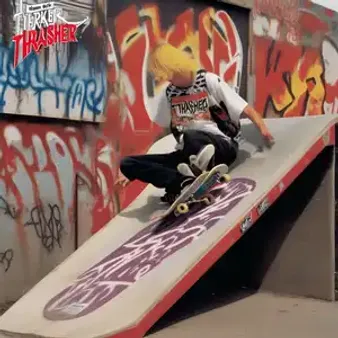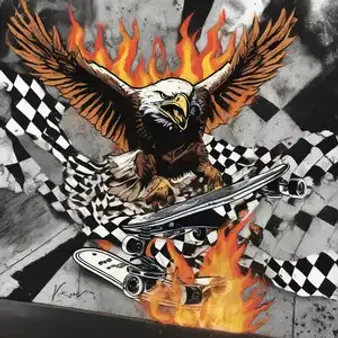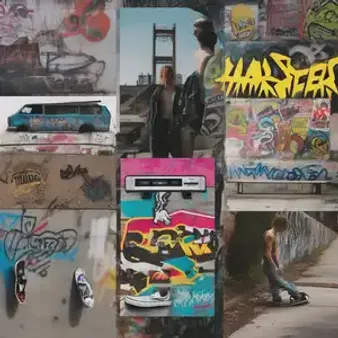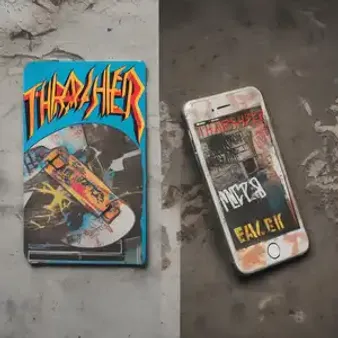Table of Contents
Kickflip back to the 1990s, a time when grunge ruled the airwaves and skateboarding was experiencing a radical transformation. At the heart of this revolution was Thrasher Magazine, a publication that not only documented but also shaped the decade's skate culture. Join kizworld as we grind through the archives, exploring how Thrasher Magazine became synonymous with the 90s skateboarding scene.
Aspect | Description |
|---|---|
Role | Documenting and shaping 90s skate culture |
Visuals | Gritty photography, iconic graphics, rebellious aesthetic |
Content | Skateboarding news, interviews, photography, irreverent humor |
Impact | Defined skateboarding's rebellious spirit, influenced style and tricks |
Legacy | Remains a respected voice in skateboarding, a symbol of 90s nostalgia |
Thrasher Magazine: A Defining Voice of the 90s Skate Scene
The Pulse of Skate Culture
Imagine a magazine that felt like hanging out with your rebellious older brother – that was Thrasher in the 90s. It wasn't glossy or corporate; it was raw, edgy, and unafraid to celebrate the spills and thrills of skateboarding. Every issue was packed with gnarly photos of skaters pushing the limits, interviews that felt like eavesdropping on legends like Tony Hawk (check out our post on skate Tony Hawk for more on this icon!), and reviews of the newest gear that had kids emptying their piggy banks.
More Than Just Tricks
But Thrasher was more than just a magazine; it was a community. It gave a voice to the outsiders, the rebels, the kids who found freedom and creativity on four wheels. Whether you were into street skating, hitting up vert ramps (learn more about vert skating here), or just loved the rebellious spirit, Thrasher made you feel like you were part of something bigger. It was like a secret handshake, a way of recognizing your tribe in a world that didn't always get it.
Element | Thrasher's Take |
|---|---|
Photography | Gritty, action-packed, capturing the raw energy of skating |
Interviews | Unfiltered, honest conversations with skateboarding legends |
Gear Reviews | In-depth and opinionated, guiding readers on the best equipment |
Thrasher Magazine: A Defining Voice of the 90s Skate Scene
Iconic Photography and Graphics in 90s Thrasher Magazines
Grit and Glory: Capturing the Essence of 90s Skateboarding
Think about the coolest skateboard photography you've ever seen – chances are, Thrasher Magazine in the 90s did it first (and better!). They didn't just take pictures; they captured the soul of skateboarding. It was all about raw energy, crazy stunts, and the "no pain, no gain" attitude that made the sport so exciting. Imagine a photographer hanging out of a car window to get the perfect shot of a skater flying down a hill – that was Thrasher! They weren't afraid to get dirty or take risks to show skateboarding's wild side.
One time, I was flipping through an old Thrasher, and there was this epic photo of a skater grinding down a huge handrail. The way they captured the speed, the focus on the skater's face, and the sparks flying off the metal – it was like something out of an action movie! That's what made Thrasher's photography so special. It wasn't just about showing off tricks; it was about capturing the feeling of skateboarding, the adrenaline, the fearlessness, and the pure joy of it all.
Element | Description |
|---|---|
Black and White Photography | Added a raw, gritty aesthetic. Emphasized shadows and contrast, creating a sense of drama and intensity. |
Fish-Eye Lenses | Created a distorted, in-your-face perspective. Exaggerated the height of jumps and the angles of tricks, adding to the sense of danger and excitement. |
Action Shots | Captured skaters mid-air, grinding rails, and pushing their limits. Conveyed the speed, agility, and risk-taking nature of skateboarding. |
From Skulls to Screaming Eagles: The Art of Thrasher's Graphics
Now, let's talk about those iconic Thrasher graphics! They were like the band T-shirts of the skateboarding world – instantly recognizable and cooler than cool. We're talking about flaming skulls, screaming eagles, gnarly fonts, and that iconic "Thrasher" logo that felt like a badge of honor to wear. These designs weren't just slapped on a page; they were works of art that perfectly captured the rebellious, in-your-face spirit of skateboarding in the 90s. Think about how excited you get when you see a cool new WKND Skateboards design - that's the kind of impact Thrasher's graphics had!
I remember wanting every single Thrasher shirt and sticker I could get my hands on. Wearing that logo felt like joining a secret society of skaters who understood the thrill of landing a tricky ollie or the frustration of a wipeout. It was a way of showing the world you were part of something authentic, something raw, and something totally awesome.
- Skulls: A symbol of rebellion and living on the edge, often depicted with flames or other edgy elements.
- Eagles: Represented freedom, power, and the soaring feeling of skateboarding, often drawn with sharp claws and a fierce expression.
- Flaming Text: Added a sense of danger and excitement, often used for headlines or to emphasize key words and phrases.
Iconic Photography and Graphics in 90s Thrasher Magazines
Thrasher Magazine's Impact on 90s Skate Culture
Imagine a time before YouTube and Instagram, when you couldn't just pull up a trick tutorial in seconds. That's where Thrasher came in. It wasn't just about looking cool (though it definitely did that!); it was like a guidebook for a generation of skaters. Thrasher showed us what was possible on a skateboard. We're talking crazy street lines, massive air on vert ramps, and tricks we could barely wrap our heads around. Suddenly, everyone wanted to learn how to kickflip like Jamie Thomas or grind a handrail like Eric Reynolds.
Shaping Style and Sound
But Thrasher's influence went way beyond just tricks. It shaped how skaters dressed, what music they listened to, and even how they talked (gnarly, dude!). Remember those baggy jeans, bandanas, and Vans slip-ons? Thank Thrasher (and maybe check out our post on New Balance SB for a modern twist on skate style). And don't even get me started on the music! Thrasher introduced us to bands like Black Flag, Minor Threat, and Dinosaur Jr., creating the soundtrack for a generation of rebellious spirits.
A Platform for Rebellion
Thrasher was never afraid to be loud, proud, and a little bit dangerous. It celebrated the rebellious spirit of skateboarding, the DIY attitude, and the idea that it was okay to be different. They weren't trying to please everyone; they were speaking directly to the kids who felt like they didn't quite fit in. It was this authenticity that made Thrasher so powerful. It was like they were saying, "We see you, we hear you, and we think you're awesome just the way you are."
The "Thrasher Effect"
Of course, with all this influence came some controversy. Some people thought Thrasher glorified the riskier side of skateboarding and encouraged kids to get into trouble. But for many of us, Thrasher was just a reflection of what was already happening. It was a place where we could be ourselves, push our limits, and find a community of like-minded misfits. And hey, maybe it even inspired a few kids to pick up a skateboard and find their own voice. For a trip down memory lane, check out our post on the history and culture of skateboarding.
Impact | Example |
|---|---|
Trick Progression | Popularized street skating and innovative tricks, pushing the boundaries of what was considered possible. |
Style Influence | Promoted a distinctive "skate rat" aesthetic, embracing baggy clothing, bandanas, and skate shoes. |
Music Connection | Introduced readers to punk rock, hardcore, and alternative music, creating a soundtrack for the skateboarding lifestyle. |
Thrasher Magazine's Impact on 90s Skate Culture
From Print to Digital: Thrasher Magazine's Evolution
Remember when you had to wait a whole month for a new Thrasher magazine? It was like torture, waiting to see the latest skate pics and read about what your favorite skaters were up to! Then came the internet, and things started changing. Thrasher, always one to keep up with the times (and the skaters!), jumped right into the digital world. They launched their website, which was like a 24/7 skate park for news, videos, and those iconic photos. It was a game-changer! Suddenly, you could get your Thrasher fix anytime, anywhere. They even started making their own videos, taking you behind the scenes at contests, on crazy skate trips, and giving you a front-row seat to the gnarliest tricks. It was like Thrasher was right there in your pocket, keeping the stoke alive every single day. If you're curious about the evolution of skateboarding itself, check out this cool post about the history and culture of skateboarding.
From Print to Digital: Thrasher Magazine's Evolution
Thrasher Magazine in the 90s wasn't just a magazine; it was a cultural phenomenon. Through raw photography, irreverent humor, and unwavering dedication to skateboarding's core values, it became the bible for a generation. While the 90s may be long gone, Thrasher's influence continues to resonate, reminding us of an era when skateboarding was raw, rebellious, and undeniably authentic.